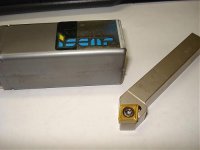Ben,
How does the tool look? Not worth a damn! I should figure out how to do pictures. I'll try with words.
Viewed from the top, the tool will have a leading (cutting) edge angled at about 15 degrees. The leading edge clearance should be sufficient to allow the fastest feed rate you might want to cut. The end of the tool will have clearance. Let's call it 5 degrees for those who must quantify things!
Viewed from the front, the tool will have a nearly knife edge with a "U" shaped groove approximately 1/8 inch across right behind the cutting edge and parallel to it so the cutting edge will be quite fragile in appearance. This is what I mean by a modified chip breaker. It's not so much a chip breaker as a chip curler. 416 stainless is a bit problematic in that the chip is likely to be stringy. When the feed and speed are right though, the chip should curl nicely and you can break it off when the chip is about 4 to 6 inches long (use a pair of pliers for this or a hook). A pretty good feed rate gives a better chip.
I have ground tools out of brazed carbide tools butthe carbide IS fragile so High Speed Cobalt works better. Coolant is good if you have it. The tool will last a lot longer.
Tools ground from Atlas Sabre will usually turn a couple of 1 1/4 Chromoly blanks to a #3 contour before sharpening is required. Stainless, though usually a bit softer, is harder on the tool and one barrel per sharpening is about it. This is with no coolant. With coolant flooding the tool, tool life is tripled.
I have used this type of tool (but with carbide) and setup for general machining as well when turning a long shaft or tube. A 6"x 5 1/4" tube eight feet long is a lot more prone to chatter than a 30 inch barrel. Even worse since the material is seldom stress relieved and wants to warp.
Tapering a barrel is really no big deal and is something most gunsmiths used to do as a matter of course.
I got this tool form from a Kamloops BC gunsmith named Art Bourne. Art got it from a Saskatchewan barrelmaker named Al Petersen who got it from Ackley or so I was told. Anyway, it works fine.
If a barrel shows a tendency to warp, that means it was improperly stress relieved. If this is the case, stop turning! While it isn't possible to do a proper job of stress relieving without a proper furnace, you can do reasonably well in the kitchen oven (this technique is best timed to co-incide with a day long shopping trip by your partner). Just throw it in the oven, turn it up as high as it will go and leave it for 5 or 6 hours. Then turn off the oven and remove the barrel(s) the next morning. While there will likely be some stress remaining, it will be much improved and it should be possible to do the job. Once again, this isn't something you are likely to run into; especially since you are not turning it down that much. Regards, Bill.



